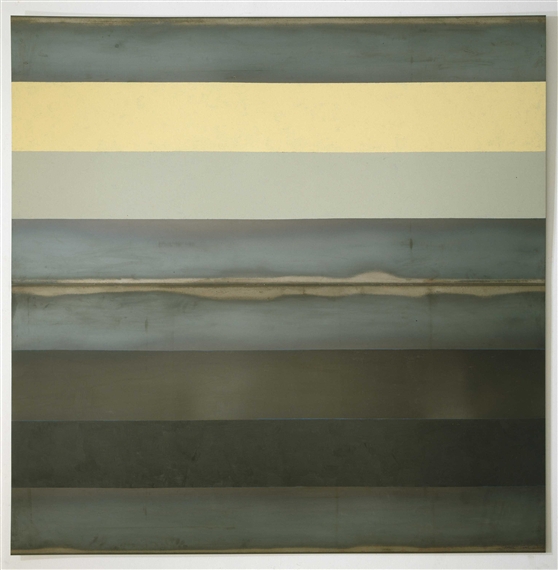If you stand up close to
Merrill Wagner’s painting “Overcast” at her current exhibition Thoughts of Form and Color at Sundaram Tagore Gallery, be careful when backing up. You may trip over “Mars Violet,” a neat block of painted slate and marble just rearward. From a safer viewing distance, two large, steel cut-out wall works, “Cattails” and “Small Flower with Buttercups,” come into view on either side of “Overcast,” forming a neat stage set complete with prop (“Mars Violet”), which dashes our expectations of painting present and past.
“Overcast” is a brooding, imposing composition that alternates vertical bands of paint and raw steel to suggest, not to render, a landscape motif. Steel’s natural patina lends atmosphere and activates the comparatively static areas of paint. Thus far, we are on familiar, stable ground, with one foot in the history of reductive, high-minded, late 20th-century abstraction. By these standards, “Cattails”—which is essentially a seven-foot, two-dimensional representation of the plant—is unconscionable. Not only is it not abstract, it is light-hearted and plant green! What would Mondrian say? “Small Flower with Buttercups” fares little better. And the stage-set presentation! One can imagine the pantheon of (mostly male) monumental steel sculptors twitching with irritation before this display.
In this lies the joy and originality of Wagner’s art. She confounds the rigor and austerity of one painting with the humor and lightness of another. Most of the work in the exhibition is steel, a pretty heavy point of departure, and Wagner has thrown in a variety of stone and concrete to further tip the scales. Occasionally, when captivated by a particularly stark sculpture such as “Wedding Present”—a crisp, geometric drawing in white oil pastel on a small block of slate—I found the playfulness of the surrounding work distracting. But for the most part, the duality of Thoughts of Form and Color is a success and the risk involved allows for all sorts of interesting occurrences, such as the pairing of two paintings on steel, “More Rain” and “Running.”
“More Rain” is among the exhibition’s darkest and starkest paintings: several vertical bands of black paint against steel. In form and theme, “Running” is an angled, dynamic composition that calls Constructivism to mind. While the former painting preoccupies itself with the paradoxical stillness that the constant motion of falling rain can sometimes evoke, the latter is animated by the propulsive action it portrays.
Thoughts of Form and Color brings together two major strains in Wagner’s work with a minor third. The large steel cut-out wall pieces, evocative of plant life, comprised her last solo exhibition at Tagore, which integrated some freestanding sculpture (the minor third) but excluded the more classically geometric abstraction present here. The sculpture could make for its own exhibition, where the artist might bring to full effect the architectural dimension of this side of her output—the way the steel gratings and slabs of concrete Wagner pulls from the streets seem to play with the architecture of the gallery. Wagner’s abstractions on canvas are currently on view uptown at the Leslie Heller Gallery accompanied by work by Mary Hambleton and
Cordy Ryman. Wagner’s “Sunspot” drawings, colored tracings of cast shadows on stone, and her landscape paintings fill out this playful artist’s repertoire.


